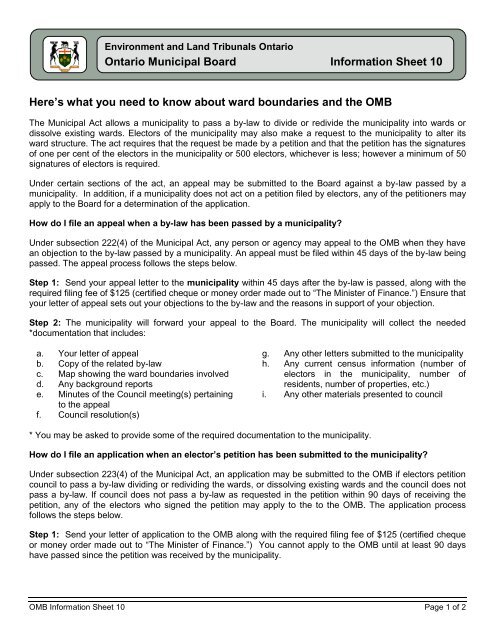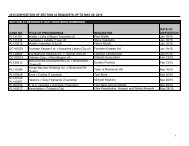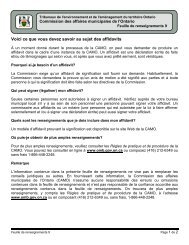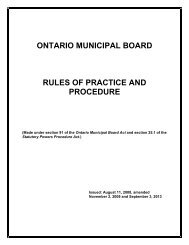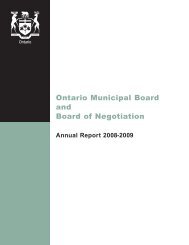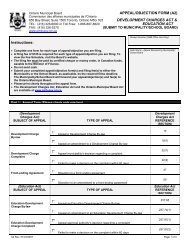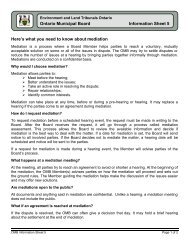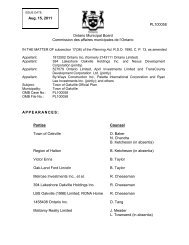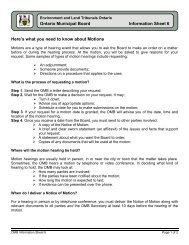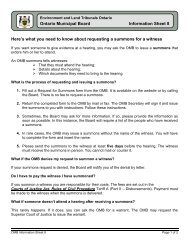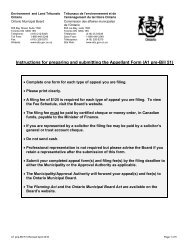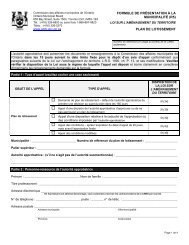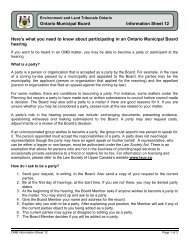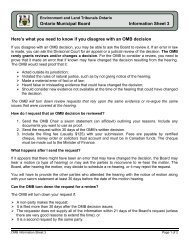Ward Boundaries (PDF) - Ontario Municipal Board
Ward Boundaries (PDF) - Ontario Municipal Board
Ward Boundaries (PDF) - Ontario Municipal Board
You also want an ePaper? Increase the reach of your titles
YUMPU automatically turns print PDFs into web optimized ePapers that Google loves.
Environment and Land Tribunals <strong>Ontario</strong><br />
<strong>Ontario</strong> <strong>Municipal</strong> <strong>Board</strong> Information Sheet 10<br />
Here’s what you need to know about ward boundaries and the OMB<br />
The <strong>Municipal</strong> Act allows a municipality to pass a by-law to divide or redivide the municipality into wards or<br />
dissolve existing wards. Electors of the municipality may also make a request to the municipality to alter its<br />
ward structure. The act requires that the request be made by a petition and that the petition has the signatures<br />
of one per cent of the electors in the municipality or 500 electors, whichever is less; however a minimum of 50<br />
signatures of electors is required.<br />
Under certain sections of the act, an appeal may be submitted to the <strong>Board</strong> against a by-law passed by a<br />
municipality. In addition, if a municipality does not act on a petition filed by electors, any of the petitioners may<br />
apply to the <strong>Board</strong> for a determination of the application.<br />
How do I file an appeal when a by-law has been passed by a municipality?<br />
Under subsection 222(4) of the <strong>Municipal</strong> Act, any person or agency may appeal to the OMB when they have<br />
an objection to the by-law passed by a municipality. An appeal must be filed within 45 days of the by-law being<br />
passed. The appeal process follows the steps below.<br />
Step 1: Send your appeal letter to the municipality within 45 days after the by-law is passed, along with the<br />
required filing fee of $125 (certified cheque or money order made out to “The Minister of Finance.”) Ensure that<br />
your letter of appeal sets out your objections to the by-law and the reasons in support of your objection.<br />
Step 2: The municipality will forward your appeal to the <strong>Board</strong>. The municipality will collect the needed<br />
*documentation that includes:<br />
a. Your letter of appeal<br />
b. Copy of the related by-law<br />
c. Map showing the ward boundaries involved<br />
d. Any background reports<br />
e. Minutes of the Council meeting(s) pertaining<br />
to the appeal<br />
f. Council resolution(s)<br />
g. Any other letters submitted to the municipality<br />
h. Any current census information (number of<br />
electors in the municipality, number of<br />
residents, number of properties, etc.)<br />
i. Any other materials presented to council<br />
* You may be asked to provide some of the required documentation to the municipality.<br />
How do I file an application when an elector’s petition has been submitted to the municipality?<br />
Under subsection 223(4) of the <strong>Municipal</strong> Act, an application may be submitted to the OMB if electors petition<br />
council to pass a by-law dividing or redividing the wards, or dissolving existing wards and the council does not<br />
pass a by-law. If council does not pass a by-law as requested in the petition within 90 days of receiving the<br />
petition, any of the electors who signed the petition may apply to the to the OMB. The application process<br />
follows the steps below.<br />
Step 1: Send your letter of application to the OMB along with the required filing fee of $125 (certified cheque<br />
or money order made out to “The Minister of Finance.”) You cannot apply to the OMB until at least 90 days<br />
have passed since the petition was received by the municipality.<br />
OMB Information Sheet 10 Page 1 of 2
NOTE: For any changes in ward boundaries to be effective for the municipal elections, an OMB Order must be<br />
issued before January 1 of the election year. Therefore, it is very important that any application be made to the<br />
<strong>Board</strong> as soon as possible to allow time for the <strong>Board</strong> to hold a hearing and issue an order.<br />
Your letter of application must include:<br />
1. A copy of the petition filed with the municipality along with an indication of the date that the petition was<br />
filed.<br />
2. Full name and contact information for the applicants (phone, fax, e-mail, address). If more than one<br />
individual has made the application, the name of the spokesperson for the group.<br />
3. A clear indication of the request being made in the application if the petition itself does not clearly note<br />
the full nature of the application. If the application is to divide the municipality into wards or redivide the<br />
existing wards, a map showing the existing wards (if any) and the desired ward boundaries.<br />
4. Copies of any additional material filed with the municipality in support of the petition.<br />
Step 2: The <strong>Board</strong> may ask for additional information from the municipality, which may include a request that<br />
the municipality confirm that the petition meets the requirements of the act.<br />
What happens after the appeal or application is received by the OMB?<br />
The OMB will review the appeal or application, and if it’s complete and meets the requirements of the act (such<br />
as filing deadlines), then the OMB will schedule a hearing. After the hearing, the <strong>Board</strong> will issue a decision<br />
and order.<br />
Where can I get more information?<br />
For more detailed information about appealing ward boundaries, please see the <strong>Municipal</strong> Act, sections 222<br />
and 223. The act is available to view online at www.e-laws.gov.on.ca. You may also contact the <strong>Board</strong> at (416)<br />
212-6349 or toll free at 1-866-448-2248.<br />
Please Note<br />
The information contained in this information sheet is not intended as a substitute for legal or other advice, and<br />
in providing this information, the <strong>Ontario</strong> <strong>Municipal</strong> <strong>Board</strong> (OMB) assumes no responsibility for any errors or<br />
omissions in this information sheet, and shall not be liable for any reliance placed on the information in this<br />
information sheet. Additional information, including the OMB’s Rules of Practice and Procedure, is available at<br />
www.omb.gov.on.ca, or by calling (416) 212-6349 or toll free 1-866-448-2248.<br />
The Environment and Land Tribunals <strong>Ontario</strong> (ELTO) includes the Assessment Review<br />
<strong>Board</strong>, <strong>Board</strong> of Negotiation, Conservation Review <strong>Board</strong>, Environmental Review Tribunal,<br />
<strong>Ontario</strong> <strong>Municipal</strong> <strong>Board</strong>, Niagara Escarpment Hearing Office and the Office of Consolidated<br />
Hearings. The Tribunals operate under specific legislative requirements and share resources and<br />
best practices. The <strong>Ontario</strong> <strong>Municipal</strong> <strong>Board</strong> hears appeals and applications on a wide range of<br />
municipal and land-related matters including official plans, zoning by-laws, subdivision plans,<br />
consents and minor variances, land compensation, development charges, ward boundaries, and<br />
aggregate resources. For more information contact us at:<br />
Environment and Land Tribunals <strong>Ontario</strong><br />
655 Bay Street, Suite 1500, Toronto, ON M5G 1E5<br />
Telephone: (416) 212-6349 or toll free: 1-866-448-2248<br />
Website: www.elto.gov.on.ca<br />
ISBN 978-1-4435-3453-6 / © Queen’s printer for <strong>Ontario</strong>, 2013<br />
Ce que vous devez savoir sur les limites des quartiers<br />
électoraux et la CAMO<br />
OMB Information Sheet 10 Page 2 of 2


